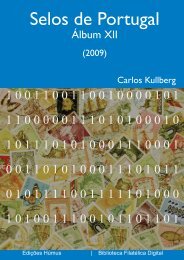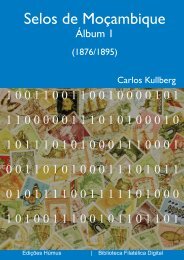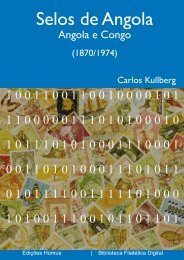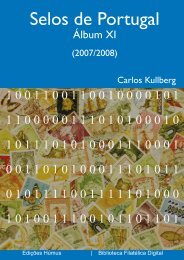PATH FORMULATION FOR A MODAL FAMILY 1 { Introduction - FEP ...
PATH FORMULATION FOR A MODAL FAMILY 1 { Introduction - FEP ...
PATH FORMULATION FOR A MODAL FAMILY 1 { Introduction - FEP ...
You also want an ePaper? Increase the reach of your titles
YUMPU automatically turns print PDFs into web optimized ePapers that Google loves.
PORTUGALIAE MATHEMATICA<br />
Vol. 58 Fasc. 3 { 2001<br />
Nova Serie<br />
<strong>PATH</strong> <strong><strong>FOR</strong>MULATION</strong> <strong>FOR</strong> A <strong>MODAL</strong> <strong>FAMILY</strong><br />
M. Aguiar, S. Castro and I. Labouriau<br />
Abstract: Persistent bifurcation diagrams in unfoldings of the modal family<br />
g(x ) = "x 4 +2ax 2 + 2 are described using path formulation: each bifurcation<br />
problem in the unfoldings of g is reinterpreted as a -parametrized path in the universal<br />
unfolding of x 4 . The space of unfolding parameters for the modal family is divided into<br />
regions where bifurcation problems are contact-equivalent and the bifurcation diagrams<br />
for these persistent problems are shown.<br />
1 { <strong>Introduction</strong><br />
In bifurcation problems small perturbations in auxiliary parameters can give<br />
rise to drastic changes in bifurcation diagrams.<br />
(1)<br />
Given the modal family of one parameter bifurcation problems<br />
g(x ) = "x 4 +2ax 2 + 2 <br />
where = 1 and the modal parameter a satis es a 2 6= " , and given a versal<br />
unfolding of g we want toenumerate, up to equivalence, the bifurcation diagrams<br />
in that unfolding.<br />
Received: March 27, 2000 Revised: February 1, 2001.<br />
AMS Subject Classi cation: 34D10, 58F14.<br />
Keywords: Bifurcation Path Formulation Singularities.
2 M. AGUIAR, S. CASTRO and I. LABOURIAU<br />
In this work we use the notation of Golubitsky and Schae er [2]. The form<br />
of a versal unfolding of this modal family is given by Key tz in [3]. Among the<br />
possible versal unfoldings we choose:<br />
(2)<br />
G(x ~a 1 2 3 4) =<br />
= "x 4 +2~ax 2 + 2 + 1 + 2 x + 3 x 2 + 4 x <br />
where (x ~a 1 2 3 4) varies in a neighbourhood of (0 0a0 0 0 0). For<br />
most values of a (all except a nite number) the topological type of the problem<br />
is independent of the value of a, called a modal parameter. For a topological<br />
classi cation we have to consider only 4 parameters although for a di erentiable<br />
classi cation 5 parameters are necessary. Thus g has topological codimension 4<br />
and di erentiable codimension 5. For a more detailed discussion of topological<br />
and di erentiable codimension see ([2], ch. IV x1 and ch. V x6).<br />
Wewant to describe the bifurcation diagrams arising in (2) for di erentchoices<br />
of the parameters a and i i =1:::4. A point A =(a 1 2 3 4) in parameter<br />
space gives rise to a persistent bifurcation diagram if there is a neighbourhood<br />
of A in parameter space where all bifurcation diagrams are equivalent to the bifurcation<br />
diagram of A. The sources of nonpersistence are the transition varieties<br />
B, H and D denominated Bifurcation, Hysteresis and Double Limit respectively<br />
([2], ch. III x5). The transition set, =B[H[D, divides the space of the unfolding<br />
parameters into connected components containing one of the persistent<br />
perturbations of (1). In the case of this modal family we are treating transition<br />
varieties are hypersurfaces in R 5 , which renders impracticable the enumeration<br />
of the connected components of R 5 ; .<br />
In order to obtain an enumeration of the perturbed bifurcation diagrams of<br />
g, aswell as an identi cation of the regions of the universal unfolding parameters<br />
space to which they belong, we are going to resort to path formulation. Path<br />
formulation ([2], ch. III x12) relates one state variable bifurcation problem with<br />
a path through the universal unfolding of a function.<br />
In the next section we describe how we use the path formulation to identify<br />
the bifurcation problem g with a path in the parameter space of the universal<br />
unfolding of the function x 4 . Then we explain how we use the possible paths<br />
to construct the bifurcation diagrams in the unfolding of the modal family. The<br />
di erent types of local bifurcation found in this problem are presented in Section<br />
3 in the form of a dictionary. In Section 4 transition varieties and bifurcation<br />
diagrams for (2) are presented in the ( 3 2 1)-subspace of the unfolding parameter<br />
space.
2 { Path formulation<br />
(3)<br />
<strong>PATH</strong> <strong><strong>FOR</strong>MULATION</strong> <strong>FOR</strong> A <strong>MODAL</strong> <strong>FAMILY</strong> 3<br />
In order to relate the universal unfolding of g to the universal unfolding of x 4 ,<br />
we x" = 1 and rewrite the former as<br />
(4)<br />
(5)<br />
G(x 1 2 3 4) =<br />
x 4 + Ax 2 + Bx+ C <br />
= "x 4 +(2a + 3) x 2 +( 2 + 4 ) x +( 1 + 2 ) :<br />
We identify our bifurcation problem with a path<br />
! A( )B( )C( )<br />
in the space of the parameters of the versal unfolding of x 4 , by de ning the<br />
functions<br />
A( ) = 2 a + 3 <br />
(6)<br />
(7)<br />
B( ) = 2 + 4 <br />
C( ) = 1 + 2 :<br />
Let M be the surface in the 4-dimensional space (x A B C) de nedby<br />
M : x 4 + Ax 2 + Bx+ C = 0 <br />
and let m be the points of M that have vertical tangent<br />
(8)<br />
m =<br />
n<br />
(x A B C): x 4 + Ax 2 + Bx+ C = 0 ^ 4 x 3 o<br />
+2Ax+ B = 0 :<br />
We de ne (m) as the projection of m into the 3-dimensional space (A B C)<br />
as follows<br />
(9)<br />
(m) =<br />
n<br />
(A B C): 9 x: x 4 + Ax 2 + Bx + C =0 ^ 4 x 3 o<br />
+2Ax + B =0 :<br />
The variety (m) called swallowtail ([1], [4]), is shown in Figure 1. It has a<br />
curve of self-intersections and two curves of cusp points. For ease of reference we<br />
are going to call the part of the swallowtail below the line of self-intersections the<br />
pocket and the rest the tail.
4 M. AGUIAR, S. CASTRO and I. LABOURIAU<br />
The swallowtail divides (A B C)-space in regions where the numberofzeros<br />
in the unfolding of x 4 is constant. Figure 1 shows the number of zeros in each<br />
region, see also Brocker and Lander ([1], ch. 17).<br />
Fig. 1 : The swallowtail (m): projection into (A B C)-space of the points where the<br />
hypersurface M : x 4 +Ax 2 +Bx+C = 0 has a vertical tangent. The swallowtail<br />
divides the space in three components where the unfolding of x 4 has 4, 2 or 0<br />
roots as indicated. On (m) the unfolding may have 1 or 3 roots in the points<br />
indicated, or 2 roots on the creased points at the pocket | see also Figure 2.<br />
Fig. 2 : Intersection of (m), Figure 1, with the plane A = , where is a negative<br />
constant, indicating the number of zeros of the unfolding of x 4 in each region.
6 M. AGUIAR, S. CASTRO and I. LABOURIAU<br />
Fig. 4 : Intersection of (m) with the planes de ned by the lines in Figure 3.<br />
Solving A( ) = 2 a + 3 for we can write the parabolas (6) in A-parametrized<br />
form for a 6= 0:<br />
(10)<br />
8<br />
><<br />
>:<br />
= A ; 3<br />
2 a<br />
B(A) = 2 + 4<br />
<br />
A ; 3<br />
2 a<br />
C(A) = 1 + 4 a 2 (A ; 3) 2 :<br />
Each parabola lies in the vertical plane containing the line de ned by the<br />
second equation. These lines are described by an equation of the form:<br />
(11)<br />
with k and p given by<br />
(12)<br />
k = 4<br />
2 a<br />
B = kA+ p<br />
and p = 2 ;<br />
<br />
3 4<br />
2 a :<br />
The case B = constant is equivalent to 4 = 0 and 2 = constant. In the<br />
remaining cases we can write 2 as a function of 3, 2 = k 3 + p: In this<br />
study we established the value 1 for which implies that the parabolas have<br />
the concavity turned up. We do not consider the parabolas with the concavity<br />
turned down, that correspond to the case = ;1:<br />
When A tends to ;1 the graph of the parabolas with opening less than 1<br />
4<br />
is located in the interior of the swallowtail pocket and the graph of the parabolas<br />
with opening greater than 1 is located in the region above the tail of the<br />
4
<strong>PATH</strong> <strong><strong>FOR</strong>MULATION</strong> <strong>FOR</strong> A <strong>MODAL</strong> <strong>FAMILY</strong> 7<br />
swallowtail. Therefore these paths give rise to bifurcation diagrams that possess<br />
respectively four and no zeros when !;1. The opening of the parabola is determined<br />
by thevalue of the parameter a and we consider parabolas with opening<br />
less than 1<br />
which impliesjaj > 1.<br />
4<br />
The paths can be traced from left to rightorvice-versa, originating bifurcation<br />
diagrams symmetric in relation to the vertical axis. We are going to consider<br />
the case where the paths are traced from left to right, which is equivalent to<br />
considering a
8 M. AGUIAR, S. CASTRO and I. LABOURIAU<br />
we say that g is subordinate to h if g is equivalent to a germ in the universal<br />
unfolding of h. If two singularities are related by subordination, they are called<br />
adjacent.<br />
In Figure 5 we transcribe the part of Figure 1 of [3] which represents the<br />
subordination relations between some of the problems of codimension less than<br />
or equal to 5. Each line segment represents an adjacency, and indicates that the<br />
singularity oflower codimension is subordinated to that of higher codimension.<br />
Fig. 5 : Subordination relations between the bifurcation problems subordinated<br />
to the modal familiy in study with height indicating codimension.<br />
According to [3], except for singularities subordinated to modal singularities,<br />
each subordination relation between singularities of codimension less than eight<br />
can be realized through subordinations between bifurcations of consecutive codimension.<br />
In the case of our modal family, as it has topological codimendion 4 even<br />
though the codimension is 5, the germs of highest codimension in its unfolding<br />
are those of codimension 3.<br />
The bifurcation problems subordinated to the modal family g are Limit point,<br />
Simple bifurcation, Isola center, Hysteresis, Asymmetric cusp, Pitchfork, Quartic<br />
fold, Bifurcation problem number 8, Winged cusp and Bifurcation problem<br />
number 10.<br />
A universal unfolding of the Bifurcation problem number 10 is given by<br />
x 4 ; x+ + + x 2 ([2], ch. IV x4). When 0. The remaining bifurcation<br />
diagrams appear when we intersect the swallowtail with planes symmetric to<br />
those considered here.
<strong>PATH</strong> <strong><strong>FOR</strong>MULATION</strong> <strong>FOR</strong> A <strong>MODAL</strong> <strong>FAMILY</strong> 9<br />
The following is a list of how bifurcations are created.<br />
Fig. 6 : Simple limit point arises from paths intersecting the swallowtail<br />
transversely at a regular point.<br />
Fig. 7 : Simple bifurcation, ([2], ch. IV x4), arises from paths tangent to<br />
the posterior part of the swallowtail pocket.<br />
Fig. 8 : Isola center, ([2], ch. IV x4), arises from paths tangent totheswallowtail<br />
at any points not in the posterior part of its pocket.<br />
Fig. 9 : Hysteresis, ([2], ch. IV x4), arises from paths through one of the<br />
cusp points of the swallowtail.
10 M. AGUIAR, S. CASTRO and I. LABOURIAU<br />
Fig. 10 : Asymmetric Cusp, ([2], ch. IV x4), arises from paths like thisone<br />
and of its perturbations.<br />
Fig. 11 : Pitchfork, ([2], ch. IV x4), only occurs in case 7 and arises from<br />
paths crossing the swallowtail at a cusp point like this one.<br />
Fig. 12 : Winged cusp, ([2], ch. IV x4), with universal unfolding x 3 + 2 + + + x ,<br />
only appears in case 3. It arises from paths as those presented, respectively<br />
when 0.<br />
Note that Quartic fold and Bifurcation problem number 8 are absent from<br />
this list because they have a di erent origin. These bifurcations arise when we<br />
move between two planes in Figure 3, that is, when we transform the intersecting<br />
parabola itself. We shall come back tothisinSection4.
<strong>PATH</strong> <strong><strong>FOR</strong>MULATION</strong> <strong>FOR</strong> A <strong>MODAL</strong> <strong>FAMILY</strong> 11<br />
Fig. 13 : Example of paths that give rise, respectively, to<br />
a) intersection of bifurcation with hysteresis,<br />
b) tangency of bifurcation with double limit point,<br />
c) intersection of hysteresis with double limit point,<br />
d) intersection of bifurcation with hysteresis and<br />
e) intersection of hysteresis with hysteresis,<br />
that occur in the universal unfolding of the bifurcation<br />
problem number 10.<br />
3.2. Global bifurcations<br />
The simplest global bifurcation is the Double Limit, the only non-local type<br />
of generic point in the transition varieties.<br />
We nd transverse crossings of all the transition varieties, with the exception<br />
of the crossing of two Double Limit lines. This crossing corresponds to the existence<br />
of four double zeros and we have already seen that in the problem under<br />
consideration there are at most four simple zeros. The intersection of Bifurcation<br />
with Hysteresis happens in case 7, the tangency of Bifurcation with Double<br />
Limit, the intersection of Hysteresis with Double Limit and the intersection of<br />
Bifurcation with Hysteresis occur in cases 1, 2 and 3, and the intersection of<br />
Hysteresis with Hysteresis only happens in case 3.
12 M. AGUIAR, S. CASTRO and I. LABOURIAU<br />
Fig. 14 : Double limit points arise from paths crossing the<br />
swallowtail at its line of self-intersections.<br />
Fig. 15 : Tangency between Bifurcation and Double limit points,<br />
is found in cases 1, 2 and 3 and arises from paths like this.<br />
4 { The modal family<br />
We return to the discussion of bifurcation diagrams of g(x y) obtained from<br />
the intersection of a parabola with the swallowtail.<br />
From the second equation in (10) it follows that the parameters 2 and 4<br />
de ne the position of the plane containing the parabola, whereas the parameters<br />
1 and 3 induce, respectively, horizontal and vertical translations of the parabola<br />
within this plane.<br />
For each case i we sketch in ( 1 3)-plane the relative positioning of the<br />
transition lines. We also show the persistent bifurcation diagrams, discussed in<br />
Section 3, corresponding to each region. We use thin dashed lines for Simple<br />
bifurcation, bold dashed lines for Isola center, thin solid lines for Hysteresis and<br />
bold solid lines for Double Limit.
<strong>PATH</strong> <strong><strong>FOR</strong>MULATION</strong> <strong>FOR</strong> A <strong>MODAL</strong> <strong>FAMILY</strong> 13<br />
Fig. 16 : Case 1 { Sketch of the transition lines and persistent bifurcation diagrams<br />
in the ( 1 3)-plane. Conventions for the transition lines in the text.<br />
Fig. 17 : Case 2 { Sketch of the transition lines and persistent bifurcation diagrams<br />
in the ( 1 3)-plane. Conventions for the transition lines in the text.
14 M. AGUIAR, S. CASTRO and I. LABOURIAU<br />
Fig. 18 : Case 3 { Sketch of the transition lines and persistent bifurcation diagrams<br />
in the ( 1 3)-plane. Conventions for the transition lines in the text.<br />
Fig. 19 : Case 6 { Sketch of the transition lines and persistent bifurcation diagrams<br />
in the ( 1 3)-plane. Conventions for the transition lines in the text.<br />
Let be the projection of the transition set in the ( 1 2 3)-subspace of<br />
parameter space. Each plane containing a parabola is parallel to the C-axis and<br />
contains a line B = kA+ p. As we have seen in Section 2, when B = kA+ p<br />
we have 2 = k 3 + p, i.e., in the 3-dimensional subspace ( 1 2 3) wehave a<br />
plane parallel to the 1-axis that contains a line 2 = k 3 + p.<br />
To imagine the surface it is su cient tomake the connection between the<br />
( 1 3)-planes found for each case i appealing to Figure 3 and to the correspondence<br />
between the lines B = kA+ p and the lines 2 = k 3 + p.
<strong>PATH</strong> <strong><strong>FOR</strong>MULATION</strong> <strong>FOR</strong> A <strong>MODAL</strong> <strong>FAMILY</strong> 15<br />
Fig. 20 : Case 7 { Sketch of the transition lines and persistent bifurcation diagrams<br />
in the ( 1 3)-plane. Conventions for the transition lines in the text.<br />
Fig. 21 : Region in ( 1 3)-plane of case 3 and region in ( 1 3)-plane of case 7 (analogous<br />
to that of case 4) in which connection appears the bifurcation problem Quartic fold.<br />
Arrows indicating that in the transition of case 3 to case 4 the transition lines H1, D<br />
and H2 become closer and closer until they join and give rise to the transition line H3.
16 M. AGUIAR, S. CASTRO and I. LABOURIAU<br />
We arenow able to nd the bifurcation problems Quartic fold and number 8<br />
in the versal unfolding of the modal family.<br />
In the transition from case 3 to case 4 (which as we have seen is analogous<br />
to case 7) we nd the bifurcation problem Quartic fold. In Figure 21 we show<br />
the region in ( 1 3)-plane of case 3 and the region in ( 1 3)-plane of case 7<br />
in which connection appears the bifurcation problem Quartic fold. For a better<br />
understanding let us observe Figure 3 again and let us consider lines of type 3<br />
closer and closer of the line of type 4. When we make this approach the transition<br />
lines identi ed in Figure 21 as H1, D and H2 become closer and closer, until when<br />
we move to line of type 4 those transition lines join and originate the transition<br />
line identi ed H3 in Figure 21, according to the arrows.<br />
In Figure 22 we represent, in the parameter space ( ) the universal<br />
unfolding of the bifurcation problem number 8. Let us consider the intersection<br />
of Figure 22 with planes parallel to the -axis de ned by lines = k + p and<br />
=0withk 0.<br />
Fig. 22 : Universal unfolding in parameter space ( )<br />
of the bifurcation problem number 8.
<strong>PATH</strong> <strong><strong>FOR</strong>MULATION</strong> <strong>FOR</strong> A <strong>MODAL</strong> <strong>FAMILY</strong> 17<br />
In Figure 23 we show the di erent results of these intersections. We draw<br />
attention to the fact that intersection 2 is the result of intersecting Figure 22<br />
with a plane tangent to one of the curves of cusp points of the Bifurcation variety<br />
of problem number 8, and intersection 5 results of intersecting Figure 22 with<br />
the plane de ned by =0.<br />
Fig. 23 : Di erent intersections of Figure 7 with planes parallel to the<br />
-axis de ned by lines = k + p and =0 with k 0.<br />
Note that each intersection i is identi ed with a region in the ( 1 3)-plane<br />
of case i. This is not totally true in what concerns intersection 1 and case 1.<br />
What happens in case 1 is that the region in the ( 1 3)-plane that contains<br />
intersection 1 su ers the action of the passage of a Double Limit line. So, what<br />
we nd in that region is not properly intersection 1 but its result after the action<br />
of a Double Limit, see Figure 24.<br />
Furthermore, the line that gives origin to case i and the line that gives origin<br />
to intersection i represent the same line, respectively, inthe(A B)-plane and in<br />
the ( )-plane.<br />
This way weprove that bifurcation problem number 8 is subordinated to the<br />
modal family g, as promised.
18 M. AGUIAR, S. CASTRO and I. LABOURIAU<br />
Fig. 24 : Intersection 1 (Figure 8) after the action of a Double limit.<br />
ACKNOWLEDGEMENTS { The rst author bene tted from funding from Action 5.2<br />
of PRODEP, grant 3/98. The last two authors bene tted from funding from Fundac~ao<br />
para a Ci^encia e Tecnologia, Portugal, grant 2/2.1/MAT/407/94 of programme PRAXIS<br />
XXI and Centro de Matematica Aplicada da Universidade do Porto, Portugal.<br />
REFERENCES<br />
[1] Brocker, Th. and Lander, L. { Di erentiable Germs and Catastrophes, London<br />
Mathematical Society Lecture Notes Series, 17, Cambridge University Press, 1975.<br />
[2] Golubitsky, M. and Schaeffer, D.G. { Singularities and Groups in Bifurcation<br />
Theory, vol. I, Springer-Verlag, 1985.<br />
[3] Keyfitz, B.L. { Classi cation of one-state-variable bifurcation problems up to<br />
codimension seven, in \Dynamics and Stability of Systems", vol. 1, pp. 2{41, 1986.<br />
[4] Poston, T. and Stewart, I. { Catastrophe Theory and its Applications, Pitman,<br />
1978.<br />
Manuela A.D. Aguiar,<br />
Faculdade de Economia, Universidade do Porto,<br />
Rua Dr. Roberto Frias, 4200 Porto { PORTUGAL<br />
E-mail: maguiar@fep.up.pt<br />
and<br />
So a B.S.D. Castro,<br />
Centro de Matematica Aplicada, Universidade do Porto,<br />
Rua das Taipas, 135, 4050-600 Porto { PORTUGAL<br />
E-mail: sdcastro@fep.up.pt<br />
and<br />
Isabel S. Labouriau,<br />
Departamento de Matematica Aplicada, Faculdade de Ci^encias, Universidade do Porto,<br />
Rua das Taipas, 135, 4050-600 Porto { PORTUGAL<br />
E-mail: islabour@fc.up.pt



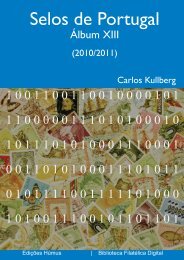
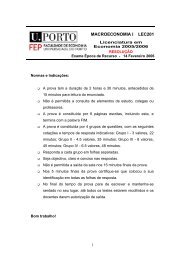
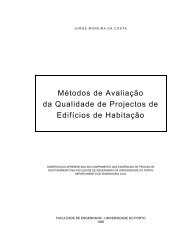
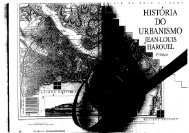
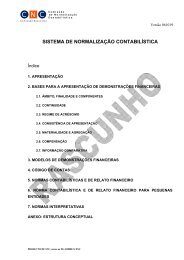

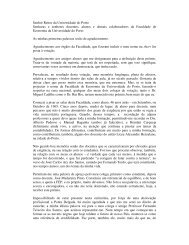
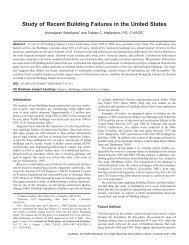
![Republica [Popular] de Moçambique. As Alterações Toponímicas e ...](https://img.yumpu.com/20789614/1/184x260/republica-popular-de-mocambique-as-alteracoes-toponimicas-e-.jpg?quality=85)

